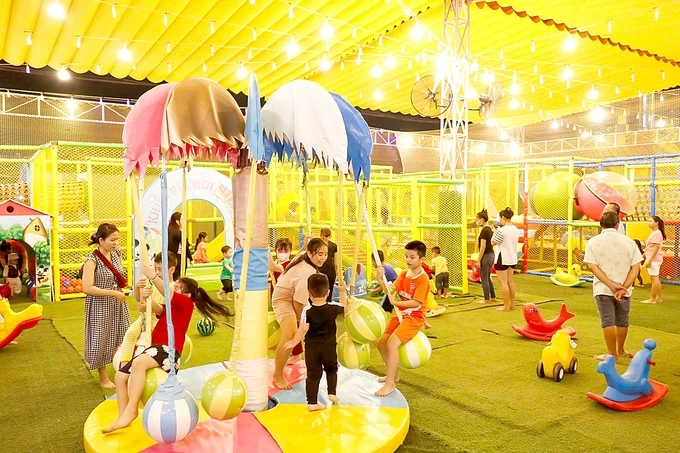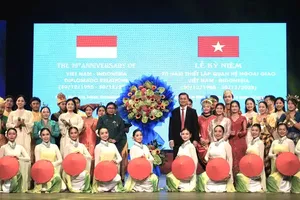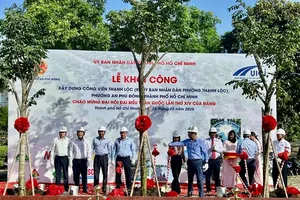
Following General Secretary To Lam’s anti-waste article – a message about anti-waste, encouraging everyone to reconsider the way of using and managing resources in the society, in recent times, a notable trend has emerged in Ho Chi Minh City, with a proactive approach being adopted in the management of vacant lots within residential areas.
A vibrant scene unfolds at Binh Trung Park in Binh Trung Dong Ward of Thu Duc City, as children engage in playful activities while adults partake in recreational exercises. This park, meticulously developed on designated parkland through the utilization of nearly VND4 billion (US$157,103) in social funding, represents one of approximately 80 public parks established within Thu Duc City.
These parks strategically leverage vacant public land within residential areas, transforming them into valuable community assets that enhance the quality of life for residents.
Notable examples of these transformed spaces include Thanh Nien Park in Tang Nhon Phu A Ward with over 2,000 square meters, Le Huu Kieu Park in Binh Trung Tay Ward with nearly 2,000 square meters, Phu Huu Park in Phu Huu Ward with nearly 3,500 square meters, and Vo Nguyen Giap Street Park in Thao Dien Ward with 5,000 square meters.
District 7 has demonstrated a commitment to enhancing the quality of life for its residents through the creation of over 60 small parks and green spaces on previously vacant land. The district has also undertaken a comprehensive revitalization of its canal corridors, incorporating the planting of fruit trees and greenery while addressing littering concerns.
This vacant land-to-park conversion initiative has received significant community support, exemplified by the enthusiastic response from residents of Ward 1 and Ward 4 in Phu Nhuan District to the transformation of the abandoned land at 750 Nguyen Kiem Street into a vibrant community space for entertainment and recreation.
At many conferences or meetings with voters in localities, people have repeatedly spoken out about the waste of abandoned public land. Leaders of some districts said they had seen such waste in the area, while entertainment facilities for people were already few, the delay in building planned parks was even more of a mistake to city dwellers. Therefore, many localities have mobilized social contributions to build parks, minimizing waste of land resources.
Over the past few months, every morning, resident Nguyen Thi Hang at residential area No. 27 in An Phu Dong Ward of District 12 has gone to the 500 square meter park in front of her house to exercise. This land is public land that has been left vacant for many years and has been turned into a garbage dump for local residents. Recently, the People's Committee of An Phu Dong Ward mobilized nearly VND250 million in social resources to renovate it into a park, installing exercise equipment for local inhabitants.
Ho Minh Hoang, Chief of Office of District 12 People's Committee, stated that the district currently possesses an extensive network of green spaces, comprising 36 green parks, 107 public green areas, and 7 green areas situated within government premises, collectively encompassing an area of nearly 32 hectares. The district remains committed to expanding its green spaces and has prioritized the review of state-managed land with the objective of investing in the development of additional parks and green areas in locations conducive to such development.
Binh Tan district is home to 110 parks and green areas with an area of more than 58 hectares. In an effort to increase the availability of green spaces within the district, the District People's Committee has issued directives to relevant units. These directives emphasize the importance of prioritizing the reclamation of land originally designated for public park purposes, as well as the reclamation of vacant land situated within residential areas.
In Thu Duc City, there are nearly 100 parks of various sizes, and the city has also utilized 60 land plots along transportation routes and small islands to enhance green spaces through tree planting. Secretary Nguyen Huu Hiep of the Thu Duc City Party Committee emphasized that the community recognizes the importance of addressing vacant land, as it not only represents a waste of land resources but also contributes to environmental pollution, while residents are in need of public areas for relaxation.
One of the key initiatives emphasized by the Thu Duc City Party Committee is the prompt and coordinated review of vacant public land in residential zones for the purpose of developing parks and green spaces. Several parks have been rapidly established through collaboration with local residents and businesses, resulting in notable destinations that facilitate healthy cultural, recreational, and sports activities for the community in Ho Chi Minh City, especially in Thu Duc City, such as Saigon Riverside Park.
To date, it can be observed that the majority of public parks in Thu Duc City have benefited from the collaboration and involvement of the community in their development, maintenance, and preservation. "While this may not seem like a monumental initiative, it represents a significant and enduring strategy for urban development. Notably, it aligns with the community's expectations and serves their needs effectively", stated Mr. Hiep.
According to statistics, Ho Chi Minh City currently has more than 400 parks, including public parks and parks in residential areas. Deputy Head Nguyen Thi Nhi of the Infrastructure Division of the Ho Chi Minh City Department of Construction said that the city is focusing on reviewing and investing in parks, green areas, and planting trees in planned park areas, polluted areas, and areas that have not yet been invested in. This is also a solution to both develop green areas and prevent waste of land resources.


















)





